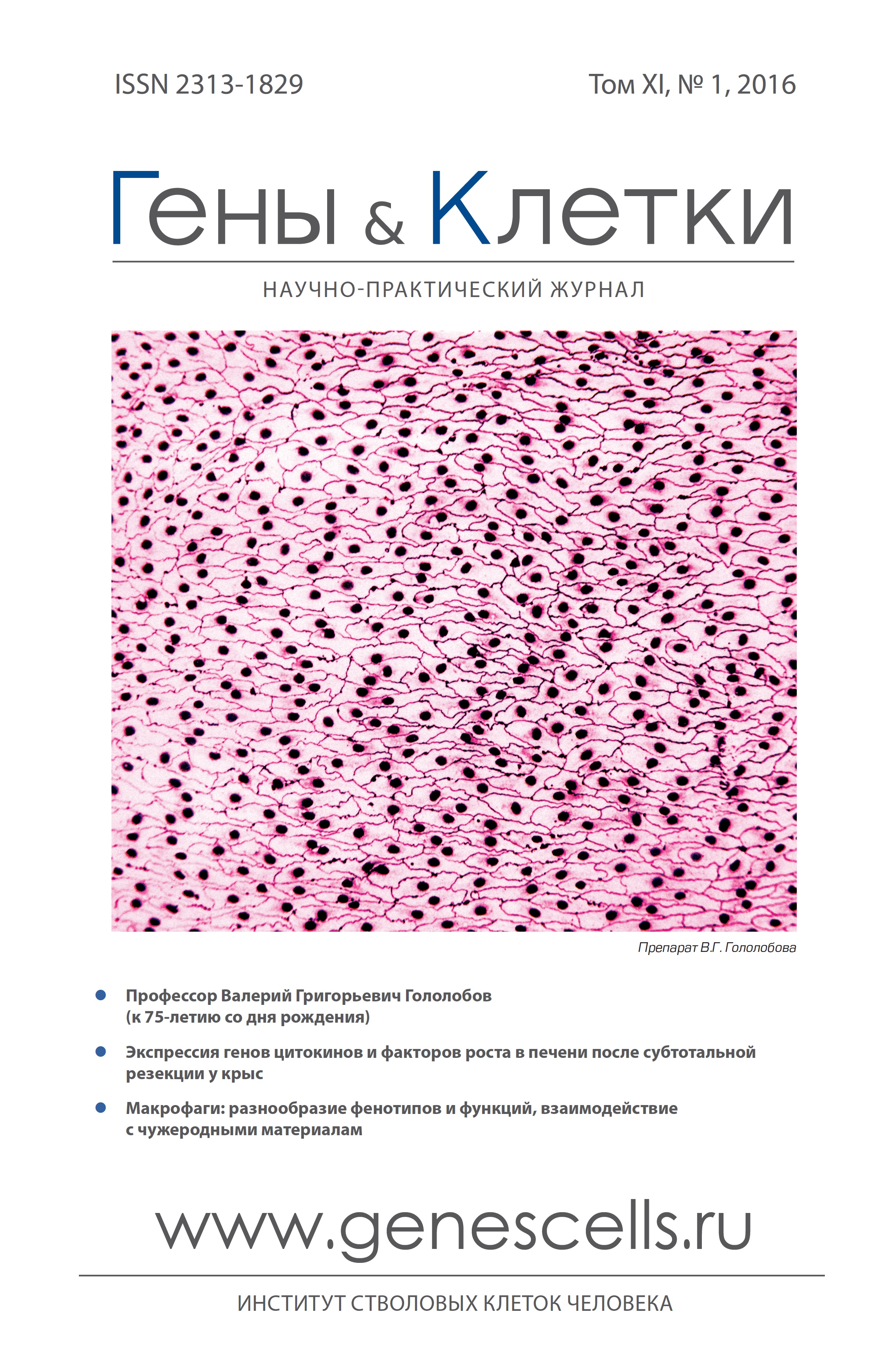Cytokines and growth factors genes expression after subtotal liver resection in rats
- Authors: Elchaninov A.V1,2,3, Fatkhudinov T.K.1,2,3, Usman N.Y1,2,3, Arutyunyan I.V1,2,3, Makarov A.V1,2,3, Kananykhina E.Y1,2, Raimova E.S.3, Bolshakova G.B2, Sukhikh G.T1
-
Affiliations:
- Research Center for Obstetrics, Gynecology and Perinatology
- Scientific Research Institute of Human Morphology
- N.I. Pirogov Russian National Research Medical University
- Issue: Vol 11, No 1 (2016)
- Pages: 61-67
- Section: Articles
- URL: https://genescells.ru/2313-1829/article/view/120578
- DOI: https://doi.org/10.23868/gc120578
- ID: 120578
Cite item
Abstract
Keywords
Full Text
About the authors
A. V Elchaninov
Research Center for Obstetrics, Gynecology and Perinatology; Scientific Research Institute of Human Morphology; N.I. Pirogov Russian National Research Medical University
T. Kh Fatkhudinov
Research Center for Obstetrics, Gynecology and Perinatology; Scientific Research Institute of Human Morphology; N.I. Pirogov Russian National Research Medical University
Email: fatkhudinov@gmail.com
N. Y Usman
Research Center for Obstetrics, Gynecology and Perinatology; Scientific Research Institute of Human Morphology; N.I. Pirogov Russian National Research Medical University
I. V Arutyunyan
Research Center for Obstetrics, Gynecology and Perinatology; Scientific Research Institute of Human Morphology; N.I. Pirogov Russian National Research Medical University
A. V Makarov
Research Center for Obstetrics, Gynecology and Perinatology; Scientific Research Institute of Human Morphology; N.I. Pirogov Russian National Research Medical University
E. Y Kananykhina
Research Center for Obstetrics, Gynecology and Perinatology; Scientific Research Institute of Human Morphology
E. Sh Raimova
N.I. Pirogov Russian National Research Medical University
G. B Bolshakova
Scientific Research Institute of Human Morphology
G. T Sukhikh
Research Center for Obstetrics, Gynecology and Perinatology
References
- Michalopoulos G.K., DeFrances M.C. Liver regeneration Science 1997; 276(5309): 60-6.
- Mitchell C., Nivison M., Jackson L.F. et al. Heparin-binding epidermal growth factor-like growth factor links hepatocyte priming with cell cycle progression during liver regeneration J Biol Chem 2005; 280(4): 2562-8.
- Ninomiyaa M., Shirabea K., Terashic T. et al. Deceleration of regenerative response improves the outcome of rat with massive hepatectomy. Am. J. Transplant. 2010; 10(7): 1580-7.
- Sowa J.P., Best J., Benko T. et al. Extent of liver resection modulates the activation of transcription factors and the production of cytokines involved in liver regeneration World J Gastroenterol 2008; 14(46): 7093-100.
- Fausto N. Liver Regeneration. J. Hepatol. 2000; 32(1 Suppl. ): 19-31.
- Fausto N., Campbell J.S., Riehle K.J. Liver Regeneration Hepatology 2006; 43(2 Suppl 1): S45-53.
- Michalopoulos G.K. Advances in liver regeneration. Expert Rev. Gastroenterol. Hepatol. 2014; 8(8): 897-907.
- Panis Y., Lomri N., Emond J.C. Early gene expression associated with regeneration is intact after massive hepatectomy in rats J Surg Res. 1998; 79(2): 103-8.
- Mason S., Daveau Y., Hiron M. et al. Differential regenerative response and expression of growth factors following hepatectomy of variable extent in rats. Liver 1999; 19(4): 312-7.
- Scotté M., Masson S., Lyoumi S. et al. Cytokine gene expression in liver following minor or major hepatectomy in rat Cytokine 1997; 9(11): 859-67.
- Pfaffl M.W. A new mathematical model for relative quantification in real-time RT-PCR. Nucleic Acids Res. 2001; 29(9): e45.
- Vandesompele J., De Preter K., Pattyn F. et al. Accurate normalization of real-time quantitative RT-PCR data by geometric averaging of multiple internal control genes. Genome Biol. 2002; 3(7): RESEARCH0034.
- Романова Л.К. Регуляция восстановительных процессов. Москва: Издательство Московского Университета; 1984
- Yanagita K., Nagaike M., Ishibashi H. Lung may have an endocrine function producing hepatocyte growth factor in response to in jury of distal organs. Biochem. Biophys. Res. Commun. 1992; 182(2): 802-9
- Kono S., Nagaike M., Matsumoto K. et al. Marked induction of hepatocyte growth factor mRNA in intact kidney and spleen in response to injury of distant organs Biochem Biophys Res Commun 1992; 186(2): 991-8.
- Rai R.M., Lee F.Y.J., Rosen A. et al. Impaired liver regeneration in inducible nitric oxide synthasedeficient mice. PNAS USA 1998; 95: 13829934.
- Coudriet G.M., He J., Trucco M. et al. Hepatocyte growth factor modulates interleukin-6 production in bone marrow derived macrophages: implications for inflammatory mediated diseases. PLoS One 2010; 5(11): e15384.
- Jetten N., Verbruggen S., Gijbels M.J. et al. Anti-inflammatory M2, but not pro-inflammatory M1 macrophages promote angiogenesis in vivo. Angiogenesis 2014; 17(1): 109-18.
- Presta M., Dell'Era P., Mitola S. et al. Fibroblast growth factor/fibroblast growth factor receptor system in angiogenesis Cytokine Growth Factor Rev. 2005; 16(2): 159-78.
- Yin S., Wang H., Park O. et al. Enhanced liver regeneration in IL-10-deficient mice after partial hepatectomy via stimulating inflammatory response and activating hepatocyte STAT3. Am. J. Pathol. 2011; 178(4): 1614-21.
- Furuyama K., Kawaguchi Y., Akiyama H. et al. Continuous cell supply from a Sox9-expressing progenitor zone in adult liver, exocrine pancreas and intestine. Nat. Genet. 2011; 43(1): 34-41.
- Bird T.G., Lu W.Y., Boulter L. et al. Bone marrow injection stimulates hepatic ductular reactions in the absence of injury via macrophage-mediated TWEAK signaling. PNAS USA 2013; 110(16): 6542-7.
- Leve L.D. Liver sinusoidal endothelial cells and liver regeneration. J. Clin. Invest. 2013; 123(5): 1861-6.
- Dalgetty D.M., Medine C.N., Iredale J.P. et al. Progress and future challenges in stem cell-derived liver technologies Am J Physiol. Gastrointest. Liver Physiol. 2009; 297: G241-8.
- Chen Y., Verfaillie C. M. MicroRNAs: the fine modulators of liver development and function. Liver Int. 2014; 34(7): 976-90.
Supplementary files










